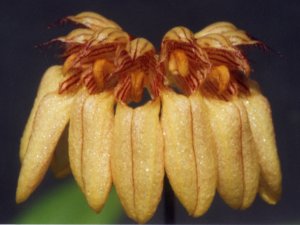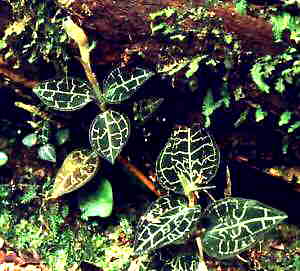|
|
|
CONTACT US
Click Here! |
| This site is best viewed with a screen resolution of 800 X 600 at high colour settings |
|
Flask list
Acacallis-Ancistrochilus Angraecum-Aspasia Barkeria-Broughtonia Bulbophyllum Capanemia-Catasetum Cattleya Cattleyopsis-Cycnoch, Cymbidium-Cyrtorchis Dendrobium-Dossinia Encyclia-Eulophiella Galeandra-Kalopternix Laelia-Lycaste Macodes-Nephalaphyll, Odontogloss,-Oncidium Paphiopedilum-Psychilis Rangaeris-Stenocoryne Tainia-Zygopetalum |
|
Plant list
Acampe-Bulbophyllum Cattleya-Dossinia Encyclia-Promeaea Renanthera-Vanda |

BP SPECIES NEWSLETTER Aug 2001Jan01 Feb Mar April May June July
Photos in this issue: Bulbophyllum Roxburghii (above), Phalaenopsis tetraspis alba, Paph malipoense, Waterfalls North Queensland ( & Pat Walters), Anoectochilus yateseae, Hetaeria polygonoidesDo you know any orchid growers who may like to receive this newsletter? Why not forward this email to them now!Items in this newsletter may be reproduced provided source acknowledged.We commend "Orchids Online Web Design" for the excellent work on our web site and this Newsletter.For information or prices click here or email Steve at steve@orchidsonline.com........A. What's New in flask.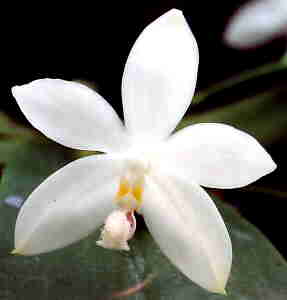 Phalaenopsis tetraspis alba x alba. Elegant waxy white
flowers on a small growing plant. A small basket or even treefern slab
with extra water would be ideal for this species. A warm grower.
Phalaenopsis tetraspis alba x alba. Elegant waxy white
flowers on a small growing plant. A small basket or even treefern slab
with extra water would be ideal for this species. A warm grower.
Rhyncostylis illustre. This is the tetraploid form of R. gigantea, short very thick leaves with a dense spike of white flowers brightly marked amethyst purple, fragrant. Best grown in a small basket, protect from excess rainwater, and ensure good ventilation. Aerides krabiense. An almost minature grower, with long arching spikes of crystalline pink flowers spotted with darker amethyst purple, the lip usually darker. Flowers are fragrant and the plant does well in a small pot or basket. Media for all these should be open, well drained and should be kept just damp and not wet. B. What's ready to replate NOW.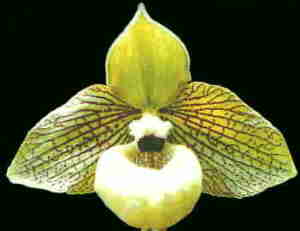
C. What's new in Plants.Bulbophyllum Roxburghii, pictured above, is a small growing, almost minature species that will form dense clumps on a slab of treefern or in a shallow tray or basket. An intermediate to warm grower from India, the flowers are produced enmasse. Like most Bulbos, a media that will stay damp but not wet is best, as they like to be damp especially when new growth is in progress.At that time, liberal water and fertiliser will quickly produce a specimen. Currently grown in a mix of shredded spaghnam and isolite, well crocked.Epidendrum stamfordianum. A showy pseudobulbous species from central America. Best grown as a Cattleya, must have excellent drainage. The flower spikes are produced from the base of the pseudobulbs, and are best left uncut until the new growths are up. A robust species, a shallow tray or basket is ideal, and when the new growths appear, lots of water and fertiliser. The spikes are branched, with many yellow flowers spotted redbrown, the lip white, yellow and also marked redbrown. D. Jewel orchids in the Wild.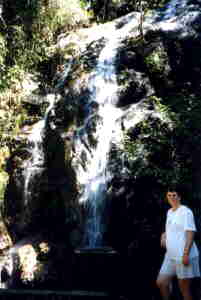
If you imagined that the delicate jewel
orchids grew, hidden away, in the moss and leaf litter of the tropical rain
forest, then you would have been as eager as we were to explore this creek.
Hidden away in the very shady spots, the plants of Anoectochilus yateseae were anchored precariously to the moss and leaf mould covered rocks and crevices, almost covered by the fallen leaves from the dense canopy overhead. Here and there, a plant had elongated its rhizome, to climb above the leaf litter. Glossy, dark green almost heart shaped leaves, to about 3 cm long, boldly veined with silver, borne at the end of a creeping rhizome. An erect inflorescence of white and green flowers held its head high to attract pollinators. Growing almost along side the Anoectochilus, were plants of a most unusual Liparis. The pseudobulbs were tall and cylindrical, topped with 2 or 3 glossy, almost emerald green leaves. The flowers, on tall erect spikes, are richly coloured, the lip deep reddish purple, the column green. We found new seed pods, the flowers having appeared during March to April, some month or more before we visited their habitat. Quite unlike other Australian Liparis, this species grew in the shade, in leaf litter and in some places, in the rich soil on the creek banks, shunning the bright, exposed rocks and tree trunks that were host to a typical Australian Liparis, Liparis cuneilabris. The flowers of this species, green and green yellow, displayed in the patches of sunlight streaming through the canopy. A few plants of Dendrobium ruppianum and tetragonum shared the tree trunks. Also in the deep shade, on a couple of wet, seeping rock faces, we found the green leafed, clambering rhizomes of Goodyera viridiflora, with its pale green flowers. The flowers were quite attractive, but its foliage was no match to the Anoectochilus and the other jewel orchid we sought. 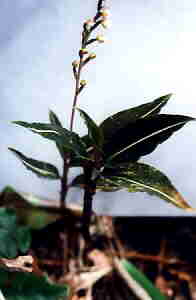
On large rocks, and on the creek banks, in the rich leafmould, we found the other sought after jewel orchid, Hetaeria polygonoides. This was a prominent inhabitant, with plants to 15 cm high, the velvety leaves lance like, dark green flushed redbrown, with a white stripe down the centre of the leaf. Tiny white flowers on an erect spike, the erect rhizome standing up above the leaf litter, to attract whatever it is that pollinates this species deep in the rainforest. 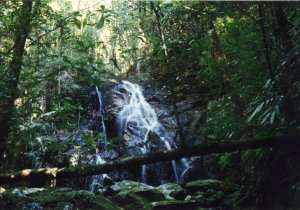
Yet this was all in a small area in one creek. The next creek over the ridge was bare. In this small area there lives a small colony of jewel orchids, they are few and far between. We took photographs and memories and left the jewel orchids there undisturbed, in the green peace and quiet of the rainforest with the music of the waterfalls and tumbling water. Photographs; Anoectochilus yateseae, in situ, atop a large rock. Hetaeria polygonoides, in situ also atop a large rock.A small waterfall, about 5 metres high, tree trunk across creek. Top; a larger water fall and Patricia Walters. For more photos go to our photos pagesE. Humour.Hear about the new sushi bar that caters exclusively to lawyers? It's called, Sosumi.A father was reading Bible stories to his young son. A little boy was attending his first wedding. After the service, his cousin
asked him, "How many women can a man marry?" |
